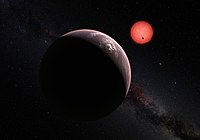TRAPPIST-1b
Template:Planetbox begin Template:Planetbox image Template:Planetbox star Template:Planetbox orbit Template:Planetbox character Template:Planetbox discovery Template:Planetbox end
TRAPPIST-1b, also designated as 2MASS J23062928-0502285 b, is an mainly rocky, Venus-like exoplanet orbiting around the ultra-cold dwarf star TRAPPIST-1, located approximately 39 light-years (12 parsecs) away from Earth in the constellation Aquarius. The planet was detected using the transit method, where a planet dims the host star's light as it passes in front of it. It was first announced on May 2, 2016, and between 2017 and 2018, more studies were able to refine its physical parameters.
The planet is about the same mass as Earth, but about 12% larger. Its relatively low density, along with spectroscopic observations, have confirmed that it has an extremely thick and hot atmosphere. Observations published in 2018 showed that the atmosphere of TRAPPIST-1b was much larger than that of Earth or Venus, as well as being very hot and potentially rich on CO2.[1] Another study, published in February 2018, determined that TRAPPIST-1b has a water-rich atmosphere with up to 10,000 times the surface pressure of Earth's atmosphere. It is noted for being quite similar to Venus.
Characteristics
Mass, radius, and temperature
TRAPPIST-1b is very close in both mass, radius and gravity to Earth. It has a radius of 1.121 R🜨, a mass of 1.02 ME, and about 81% Earth's surface gravity. However, the density of the planet indicates that it is not entirely rocky. With a density of 3.98 g/cm3, about ≤5% of its mass must be water, likely in the form of a thick Venus-like atmosphere due to its high stellar flux being nearly 4 times higher than Earth's. The planet's extremely thick atmosphere has likely risen its temperature far above its equilibrium temperature of 391.8 K (118.7 °C; 245.6 °F). Its surface temperature is estimated to be between 750 K (477 °C; 890 °F) and 1,500 K (1,230 °C; 2,240 °F), potentially as high as 2,000 K (1,730 °C; 3,140 °F). This is much hotter than the surface of Venus and can melt certain metals.[2]
Orbit
TRAPPIST-1b orbits very close to its parent star. One orbit on this planet lasts about 1.51 Earth days, or about 36 hours.[1] It orbits about 0.0115 AU from its star, just 1.2% the distance between Earth and the Sun.[2] The close proximity to its host star means that TRAPPIST-1b is likely tidally locked. It also has a very circular orbit, with an eccentricity of 0.00622, significantly more circular than Earth's orbit.
Host Star
TRAPPIST-1b orbits the ultracool dwarf star TRAPPIST-1. It is 0.121 R☉ and 0.089 M☉, with a temperature of 2511 K and an age between 3 and 8 billion years. For comparison, the Sun has a temperature of 5778 K and is about 4.5 billion years old. TRAPPIST-1 is also very dim, with about 0.0005 times the luminosity of the Sun. It is too faint to be see with the naked eye, having an apparent magnitude of 18.80.
Atmosphere
The combined transmission spectrum of TRAPPIST-1 b and c rules out a cloud-free hydrogen-dominated atmosphere for each planet, so they are unlikely to harbor an extended gas envelope. Other atmospheres, from a cloud-free water-vapor atmosphere to a Venus-like atmosphere, remain consistent with the featureless spectrum.[3]
In 2018, the planet's atmosphere was better examined with the Spitzer Space Telescope and found to be quite large and hot. The planet's transmission spectrum suggested two main possibilities for the atmosphere: one rich in carbon dioxide, and one with water vapor. The more likely CO2 atmosphere would have a scale height of approximately 52 km (with Earth's being at 8 km, and Venus's at 15.9 km) and an average temperature in excess of 1,400 K (1,130 °C; 2,060 °F), far higher than its equilibrium temperature. A water vapor atmosphere would need to have a scale height of >100 km and a temperature of >1,800 K (1,530 °C; 2,780 °F) to produce the variations seen in the planet's transit depths and its transmission spectrum. Other sources for the effects seen, such as hazes and thick clouds, would require an even larger atmosphere. TRAPPIST-1b will have to be studied further to confirm its potential large atmosphere.[1]
The refined density of TRAPPIST-1b, along with the planet's transmission spectrum, indicate that its atmosphere is made mainly of vaporized water. The atmosphere has likely risen the planet's surface temperature to about 750-1500 K, which would require an atmospheric pressure between 101 (10) to 104 (10,000) bar, potentially thicker than Venus's atmosphere. TRAPPIST-1b's atmosphere is likely very similar to that of Venus.[2]
Gallery
-
Artist's view of planets transiting red dwarf star in TRAPPIST-1 system[4]
-
The Sun and the ultracool dwarf star TRAPPIST-1 to scale. The faint star has only 11% of the diameter of the Sun and is much redder in colour.
-
Artist's impression of three of the planets (b, c, and d) orbiting TRAPPIST-1
-
Artist’s impression video, near one of the three planets orbiting TRAPPIST-1. One of the inner planets is shown in transit across the disc of its tiny and dim parent star.
See also
- 55 Cancri e, another very hot planet with a confirmed atmosphere.
References
- ^ a b c Cite error: The named reference
Delrez2018was invoked but never defined (see the help page). - ^ a b c Cite error: The named reference
Grimm2018was invoked but never defined (see the help page). - ^ de Wit, Julien; et al. (2016). "A combined transmission spectrum of the Earth-sized exoplanets TRAPPIST-1 b and c". Preprint. 537: 69–72. arXiv:1606.01103. Bibcode:2016Natur.537...69D. doi:10.1038/nature18641.
- ^ "Artist's view of planets transiting red dwarf star in TRAPPIST-1 system". www.spacetelescope.org. Retrieved 21 July 2016.

![Artist's view of planets transiting red dwarf star in TRAPPIST-1 system[4]](http://upload.wikimedia.org/wikipedia/commons/thumb/5/50/Artist%27s_view_of_planets_transiting_red_dwarf_star_in_TRAPPIST-1_system.jpg/200px-Artist%27s_view_of_planets_transiting_red_dwarf_star_in_TRAPPIST-1_system.jpg)





